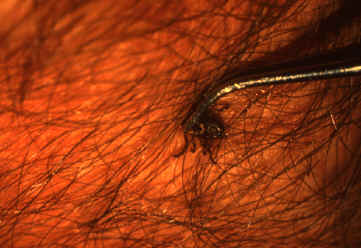Rocky Mountain spotted fever secondary prevention: Difference between revisions
Jump to navigation
Jump to search
Sergekorjian (talk | contribs) |
Sergekorjian (talk | contribs) |
||
| Line 9: | Line 9: | ||
===Removing a tick=== | ===Removing a tick=== | ||
[[Image:Removal.jpg|180px|left|thumb|Removal of an embedded tick]][[Image:Tick removal process.jpg|450px|none|thumb|Tick removal process]] | [[Image:Removal.jpg|180px|left|thumb|Removal of an embedded tick]][[Image:Tick removal process.jpg|450px|none|thumb|Tick removal process]] | ||
<br> | |||
#Use fine-tipped tweezers or notched tick extractor, and protect your fingers with a tissue, paper towel, or latex gloves. Persons should avoid removing ticks with bare hands. | #Use fine-tipped tweezers or notched tick extractor, and protect your fingers with a tissue, paper towel, or latex gloves. Persons should avoid removing ticks with bare hands. | ||
#Grasp the tick as close to the skin surface as possible and pull upward with steady, even pressure. Do not twist or jerk the tick; this may cause the mouthparts to break off and remain in the skin. (If this happens, remove mouthparts with tweezers. Consult your health care provider if illness occurs.) | #Grasp the tick as close to the skin surface as possible and pull upward with steady, even pressure. Do not twist or jerk the tick; this may cause the mouthparts to break off and remain in the skin. (If this happens, remove mouthparts with tweezers. Consult your health care provider if illness occurs.) | ||
Revision as of 18:29, 8 January 2016
|
Rocky Mountain spotted fever Microchapters |
|
Differentiating Rocky Mountain spotted fever from other Diseases |
|---|
|
Diagnosis |
|
Treatment |
|
Case Studies |
|
Rocky Mountain spotted fever secondary prevention On the Web |
|
American Roentgen Ray Society Images of Rocky Mountain spotted fever secondary prevention |
|
Rocky Mountain spotted fever secondary prevention in the news |
|
Directions to Hospitals Treating Rocky Mountain spotted fever |
|
Risk calculators and risk factors for Rocky Mountain spotted fever secondary prevention |
Editor-In-Chief: C. Michael Gibson, M.S., M.D. [1]
Overview
Secondary prevention after a tick bite include rapid and correct removal of the tick. Prophylactic antibiotic therapy is not recommended.
Secondary Prevention
Removing a tick


- Use fine-tipped tweezers or notched tick extractor, and protect your fingers with a tissue, paper towel, or latex gloves. Persons should avoid removing ticks with bare hands.
- Grasp the tick as close to the skin surface as possible and pull upward with steady, even pressure. Do not twist or jerk the tick; this may cause the mouthparts to break off and remain in the skin. (If this happens, remove mouthparts with tweezers. Consult your health care provider if illness occurs.)
- After removing the tick, thoroughly disinfect the bite site and wash your hands with soap and water.
- Do not squeeze, crush, or puncture the body of the tick because its fluids may contain infectious organisms. Skin accidentally exposed to tick fluids can be disinfected with iodine scrub, rubbing alcohol, or water containing detergents.
- Save the tick for identification in case you become ill. This may help your doctor to make an accurate diagnosis. Place the tick in a sealable plastic bag and put it in your freezer. Write the date of the bite on a piece of paper with a pencil and place it in the bag. [1]
References
- ↑ Tick Removal. Centers for Disease Control and Prevention (2015). http://www.cdc.gov/ticks/removing_a_tick.html Accessed on December 30, 2015